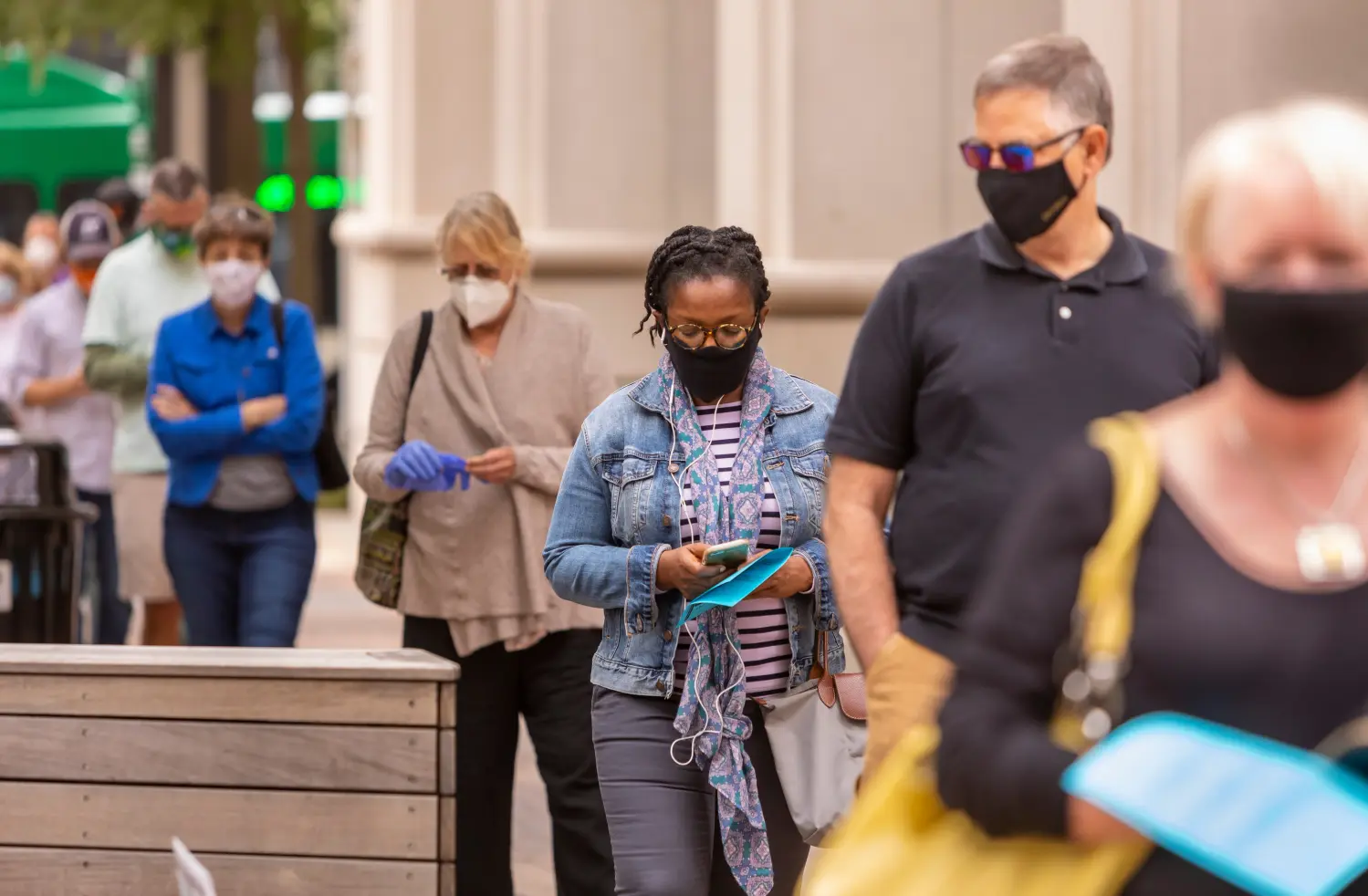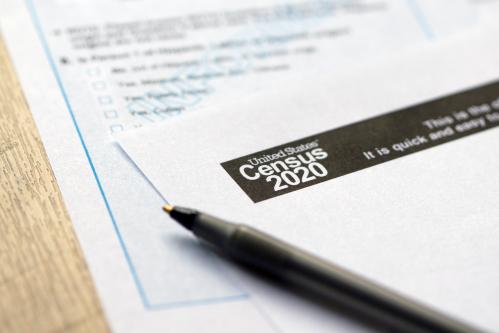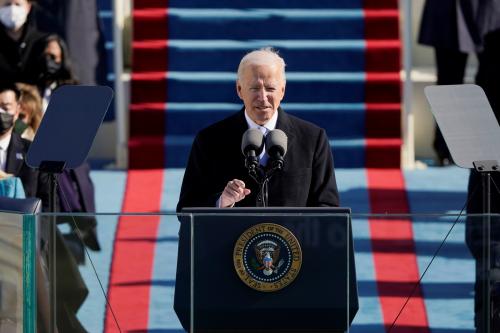The analysis in this post derives from the Census Bureau’s Voting and Registration supplement, released on April 29. These data are estimates, and may differ from vote counts reported by states.
Contents:
- Turnout surged among Asian American, Latino or Hispanic, and non-college white voters
- Gen Z propelled a surge in young adult turnout
- With the population diversifying, non-college white voters are a decreasing share
- Turnout patterns across states show large increases and notable shifts
- The swing state voting patterns that decided the election
- Voter turnout in 2020 and beyond
Voter turnout in the 2020 election was exceptionally high, with 66.8% of eligible voters casting ballots, resulting in a victory for Joe Biden. In response, some Republican-controlled state legislatures have enacted measures that would have the effect of restricting voting in future elections among groups that often vote Democratic.
However, recently released results from the Census Bureau’s Current Population Survey voting supplement indicate that 2020’s voting spike occurred across both Democratic-leaning demographic groups and Republican-leaning ones. In particular, there was a noticeable increase in voting among white adults who did not graduate from college (the so-called “non-college white” group).
The results from the Census Bureau survey provide information that was not available earlier: estimates of voter turnout for key demographic groups, both nationally and for states. The analysis below reveals how different groups’ voter turnout shifted in 2020 from 2016 and earlier elections, and what that might mean for shifts in the demographic makeup of the voter population.
Turnout surged among Asian American, Latino or Hispanic, and non-college white voters
The Census Bureau’s estimates confirm the general perception that 2020 voter turnout was very high, at 66.8%. This was the biggest turnout in a presidential election since 1992 (67.7%) and more than 5 points higher than the 2016 election.

Turnout showed distinct increases from 2016 among Asian American, Latino or Hispanic, and non-college white voters. Each displayed 2016-to-2020 turnout increases that exceeded 6 points or greater.
The non-college white rise in turnout is especially significant, as this group is linked to voting Republican in presidential elections, including in 2020. This group’s 2020 turnout rate of 64% was its highest since at least 2000, and served to close the gap between their turnout and the traditionally higher turnout of their less Republican-leaning college graduate counterparts (which rose by just 3 points, from 79% to 82%). This rise occurred among both non-college white men and women (Download Table A).

The non-college white turnout spike helped to increase the overall white turnout in 2020 (from 65% to 71%), elevating the overall white turnout level, which continues to exceed other race and ethnic groups. Yet increased turnout was also evident for Asian American voters (a 10-point increase) and Latino and Hispanic voters (a 6-point increase). Black voters also showed a turnout spurt from their dip in the 2016 election. While 2020’s Black turnout—at 63%—still exceeded that of Latino or Hispanic or Asian American voters, it remains below the rate of the two elections won by Barack Obama in 2008 and 2012 (Download Table A).
Gen Z propelled a surge in young adult turnout
Consistent with much of the recent past, older adults voted at higher rates in 2020 than their younger counterparts. However, younger age groups showed the greatest turnout increase in that election, rising by 8 points for those aged 18 to 29. In total, over half of these young adults turned out to vote.

Even more remarkable is the rise in turnout of the youngest of this group: those aged 18 to 24, who are now mostly members of “Gen Z.” This group was especially notable in 2020, as they comprised a large part of the summer’s political and racial justice protests, leading analysts to speculate if this activism would translate into voter turnout.
The answer to this question, based on the new census statistics, is a resounding “yes.” These young adult voters cast ballots at higher rates in 2020 than in any election so far this century, with turnout at more than half for Gen Z Asian American and white voters, nearly half for Gen Z Black voters, and more than two-fifths for Gen Z Latino or Hispanic voters. The impact of this voting bloc—which leaned heavily Democratic in the most recent election—was influential in many close 2020 swing states.
With the population diversifying, non-college white voters are a decreasing share
The voter population for presidential elections continues to change in its demographic makeup. This relates both to turnout and to the changing shifts in the nation’s overall population. Because of the rising growth rates of nonwhite race and ethnic groups nationally and the increased educational attainment of younger voters, the share of all voters identifying as “non-college white” continues to shrink. Thus, for the first time in a presidential election, white voters without college degrees comprised less than two-fifths of the voter population.


These changes look quite different from 2004, when non-college white voters comprised more than half of the voter population and nonwhite minorities comprised only one-fifth. Since then, the former’s share dropped to 39.7%; the share of white college-educated voters increased modestly, from 27.7% to 31.3%.; and the share of nonwhite voters rose to 29%, almost equaling that of white college graduates.
The shift in the race-ethnic makeup of the population—especially the younger population—is evident when looking at voters in the past five presidential elections. During this period, younger generations of voting-age citizens have become more racially diverse. In 2020, for the first time, at least 10% of the total voter population identified as Latino or Hispanic, as did 15% of voters below age 40. The white share of the under-age-40 voter population declined by 10 points from 2004 to 2020, to 64% (Download Table B).
Turnout patterns across states show large increases and notable shifts
National turnout shifts between 2016 and 2020 were broadly evident across individual states. Turnout rose in 44 states as well as Washington, D.C. (Download Table C).
Among the states with double-digit turnout gains was the swing state of Arizona, where turnout rose from 60% to 72%. New Jersey increased turnout from 61% to 78%, giving it the highest 2020 turnout rate of all states. Similarly, all but nine states showed turnout gains for their 18- to 29-year-old populations
Most notable are turnout shifts among white non-college and white college graduate populations. Only six states registered 2016-to-2020 turnout drops for non-college white voters, whereas 15 states showed such drops for white college graduates. In all but 11 states, turnout gains were greater for non-college white voters than for college-educated white voters. And particularly relevant for the 2020 election, both Michigan and Wisconsin registered turnout gains for non-college white voters and declines for college-educated white voters.
The swing state voting patterns that decided the election
Given the importance of the state outcomes in the Electoral College, it is useful to study turnout patterns in swing or near-swing states from the 2020 presidential election (Download Table D).
Three such states in the rapidly growth South and West regions are Georgia, Arizona, and Texas. The former two gave Biden a razor-thin win over Donald Trump; the latter, which Trump won, showed a smaller Republican margin than in recent elections.

In all three states, turnout was highest for white college graduates, and lowest for nonwhite voters. Yet in each case, 2016-to-2020 turnout increases were greater for non-college white voters than for white college graduates. Each state also exhibited sizeable gains in their nonwhite turnout rates, which countered the Republican-leaning impact of the non-college white turnout increase. This was especially the case for the large Latino or Hispanic populations in Arizona and Texas, and modestly for the Black population in Georgia.
It is the case that the white non-college bloc voted somewhat less Republican in each of these states in 2020 than in 2016. However, it appears that the rise in white non-college turnout helped to make the races in Georgia and Arizona close, and in Texas, kept the Republican margins from shrinking further.

Among northern states in 2020, the three closest presidential vote totals were in Pennsylvania, Michigan, and Wisconsin—each of which went for Trump in 2016 and Biden in 2020. These generally “whiter” states show similar shifts in turnout between 2016 and 2020. Of the three, Pennsylvania exhibited the greatest overall rise in turnout, but it was most accentuated for the state’s non-college white voters. As mentioned earlier, both Michigan and Wisconsin showed turnout declines for their college-educated white populations, although each registered turnout gains among their nonwhite populations.
The rise in turnout among non-college white voters in these states were perhaps even more instrumental in keeping their 2020 elections close than in the more racially diverse states discussed earlier. Of course, these rises were countered by the rising turnout of strongly Democratic-leaning Black populations, especially in Pennsylvania and Michigan.

Despite the rise in turnout among generally Republican-leaning white non-college voters, it is important to note this group’s decreasing share of all voters in both Sun Belt and Snow Belt battlegrounds. This is evident in the highly diverse states of Georgia, Arizona, and Texas, where the nonwhite share of voters rose considerably between 2004 and 2020. In Arizona, especially, white non-college adults dipped from over half of all voters in 2004 to 36% in 2020.
While the three northern swing states—Pennsylvania, Michigan, and Wisconsin—are less racially diverse, the impact of their white college graduate and nonwhite populations will rise over time. And for all states, the rise in diversity was even more accentuated for the under-age-40 voter group, which people of color now comprise roughly half of in Georgia, Arizona, and Texas (Download Table E).
Voter turnout in 2020 and beyond
The new census data makes plain that the 2020 election was record-breaking in terms of the magnitude of its voter turnout. Yet there are two aspects of this turnout which need to be emphasized. One is the sharp rise in the turnout among white non-college voters—a group that has strongly favored Republicans. The other is the accentuated turnout among young people and people of color—representing the increasing influence of voters who heavily lean toward Democratic presidential candidates.
Both of these groups exerted countervailing forces on the results of the 2020 election, leading to close popular vote totals in a handful of states. However, the underlying demographics of the nation’s voter population show that Democratic-leaning voter populations are on the rise in both fast-growing and slow-growing parts of the country.
This raises the question as to whether even greater turnout among white non-college voter groups—or Republican efforts to alter voting requirements in their favor—will be enough to counter the influence of young voters and voters of color in future presidential elections.





